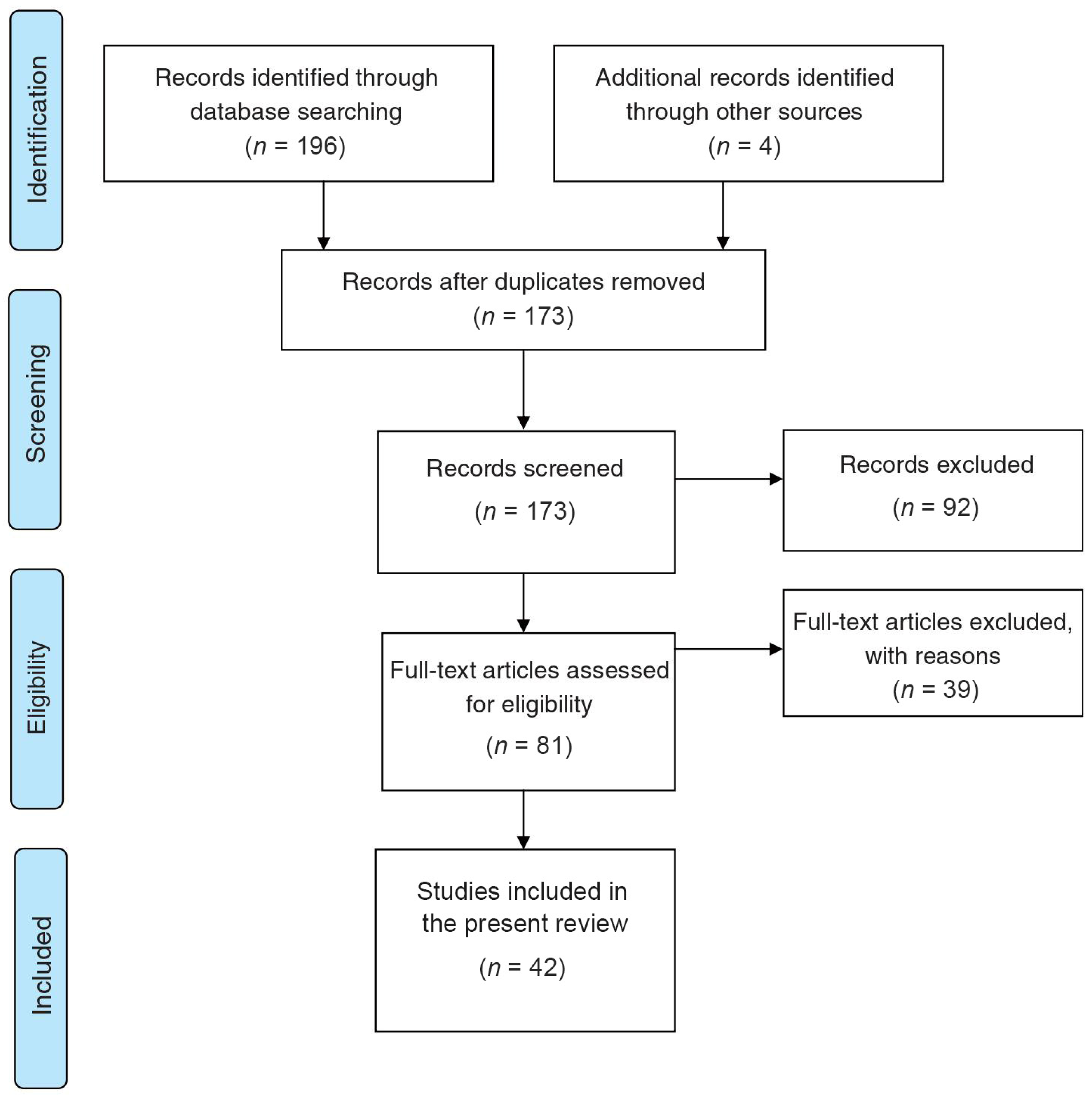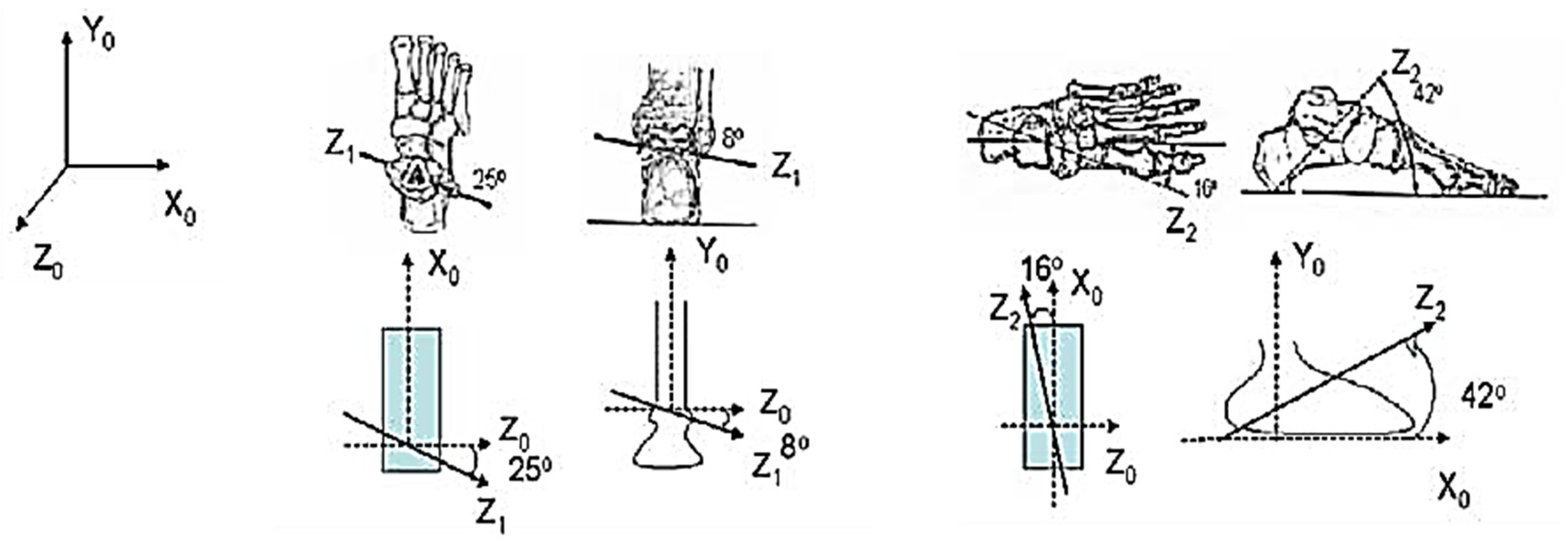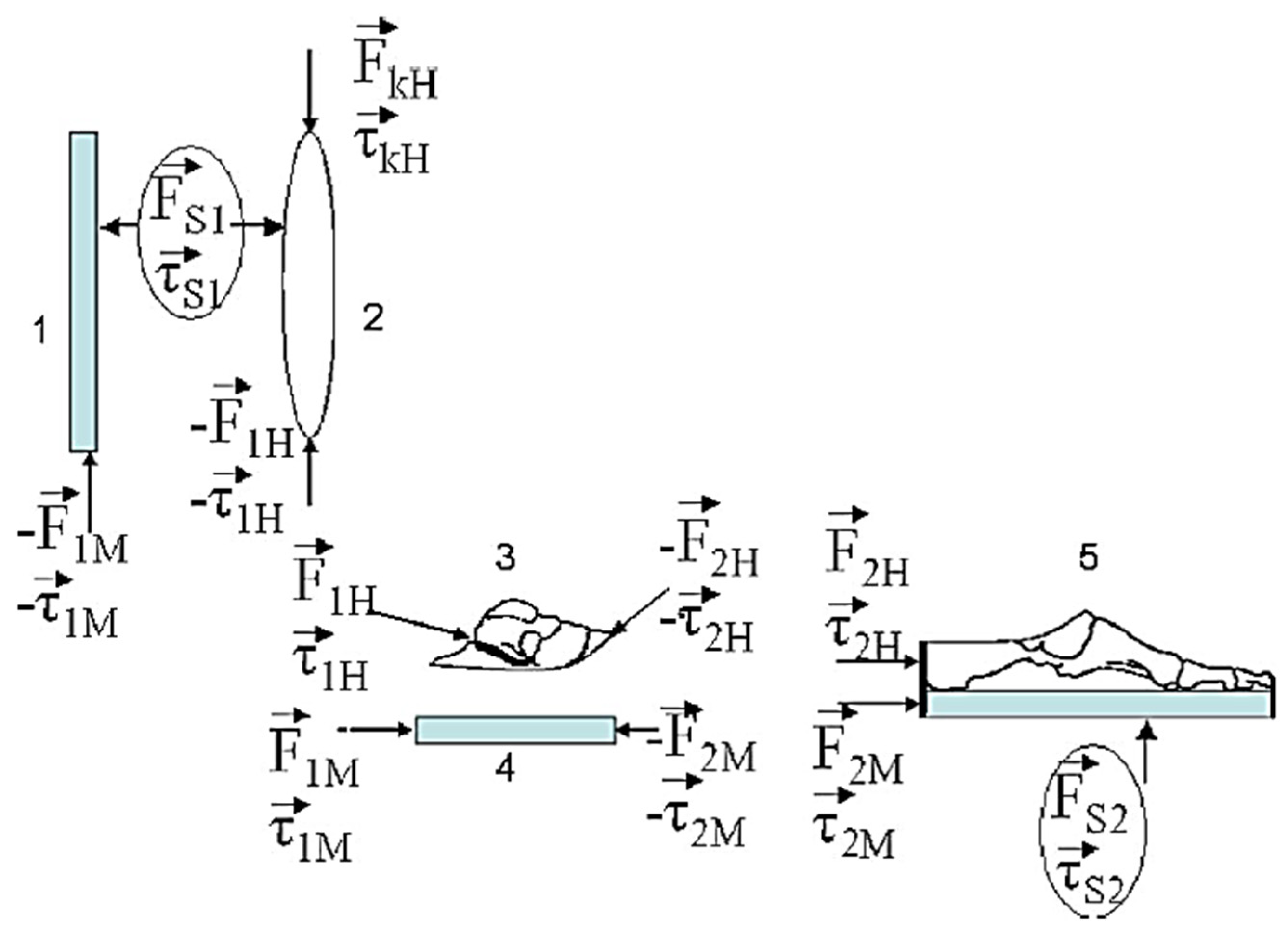An Overview of Mathematical Methods Applied in the Biomechanics of Foot and Ankle–Foot Orthosis Models
Abstract
1. Introduction
2. Methods
2.1. Search Strategy
2.2. Study Selection
- Studies considered for inclusion were numerical and not experimental or clinical studies alone;
- The means of analysis, such as equations, parameters, and methods, were clearly explained;
- The study was written in English and published in a peer-reviewed journal.
3. Results and Discussions
3.1. Nonlinear Optimization Function
3.1.1. Fully Cartesian Coordinates
3.1.2. Kinematic Analysis
3.1.3. Dynamic Analysis
3.2. Two-Degree-of-Freedom AFO for Robotic Rehabilitation
3.2.1. Model of the Foot
3.2.2. Model of the Orthosis
3.3. SMA-Element-Based AFO
3.4. Constitutive Models
3.4.1. Linear Elastic Constitutive Model
3.4.2. Viscoelastic Constitutive Model
3.4.3. Hyperelastic Constitutive Model
4. Conclusions
Author Contributions
Funding
Institutional Review Board Statement
Informed Consent Statement
Data Availability Statement
Conflicts of Interest
References
- Daryabor, A.; Arazpour, M.; Aminian, G.; Baniasad, M.; Yamamoto, S. Design and Evaluation of an Articulated Ankle Foot Orthosis with Plantarflexion Resistance on the Gait: A Case Series of 2 Patients with Hemiplegia. J. Biomed. Phys. Eng. 2020, 10, 119–120. [Google Scholar] [CrossRef] [PubMed]
- Nazha, H.M.; Szávai, S.; Darwich, M.A.; Juhre, D. Passive Articulated and Non-Articulated Ankle-Foot Orthoses for Gait Rehabilitation: A Narrative Review. Healthcare 2023, 11, 947. [Google Scholar] [CrossRef] [PubMed]
- Breitman, N.; Yona, T.; Fischer, A.G. Gait Event Detection Wearable Device Development and the Effect of Vibration Feedback on Ankle Kinematics and Kinetics. IEEE Sens. J. 2023, 23, 19052–19059. [Google Scholar] [CrossRef]
- Darwich, A.; Nazha, H.; Sliman, A.; Abbas, W. Ankle-Foot Orthosis Design between the Tradition and the Computerized Perspectives. Int. J. Artif. Organs 2020, 43, 354–361. [Google Scholar] [CrossRef] [PubMed]
- Tan, B.H.M.; Nather, A.; David, V. Biomechanics of the Foot. In Diabetic Foot Problems; World Scientific: Singapore, 2008; pp. 67–75. ISBN 9789812791511. [Google Scholar]
- Zajac, F.E.; Neptune, R.R.; Kautz, S.A. Biomechanics and Muscle Coordination of Human Walking: Part II: Lessons from Dynamical Simulations and Clinical Implications. Gait Posture 2003, 17, 1–17. [Google Scholar] [CrossRef] [PubMed]
- Raja, B.; Neptune, R.R.; Kautz, S.A. Quantifiable Patterns of Limb Loading and Unloading during Hemiparetic Gait: Relation to Kinetic and Kinematic Parameters. J. Rehabil. Res. Dev. 2012, 49, 1293–1304. [Google Scholar] [CrossRef] [PubMed]
- Otten, E. Inverse and Forward Dynamics: Models of Multi-Body Systems. Philos. Trans. R. Soc. Lond. B Biol. Sci. 2003, 358, 1493–1500. [Google Scholar] [CrossRef] [PubMed][Green Version]
- Cleather, D.J.; Bull, A.M.J. Influence of Inverse Dynamics Methods on the Calculation of Inter-Segmental Moments in Vertical Jumping and Weightlifting. Biomed. Eng. Online 2010, 9, 74. [Google Scholar] [CrossRef]
- Karatsidis, A.; Bellusci, G.; Schepers, H.M.; de Zee, M.; Andersen, M.S.; Veltink, P.H. Estimation of Ground Reaction Forces and Moments during Gait Using Only Inertial Motion Capture. Sensors 2016, 17, 75. [Google Scholar] [CrossRef]
- Buchanan, T.S.; Lloyd, D.G.; Manal, K.; Besier, T.F. Neuromusculoskeletal Modeling: Estimation of Muscle Forces and Joint Moments and Movements from Measurements of Neural Command. J. Appl. Biomech. 2004, 20, 367–395. [Google Scholar] [CrossRef]
- Lugrís, U.; Carlín, J.; Pàmies-Vilà, R.; Font-Llagunes, J.M.; Cuadrado, J. Solution Methods for the Double-Support Indeterminacy in Human Gait. Multibody Syst. Dyn. 2013, 30, 247–263. [Google Scholar] [CrossRef]
- Liu, L.; Cooper, J.L.; Ballard, D.H. Computational Modeling: Human Dynamic Model. Front. Neurorobot. 2021, 15, 723428. [Google Scholar] [CrossRef] [PubMed]
- Isler, K.; Payne, R.C.; Günther, M.M.; Thorpe, S.K.S.; Li, Y.; Savage, R.; Crompton, R.H. Inertial Properties of Hominoid Limb Segments. J. Anat. 2006, 209, 201–218. [Google Scholar] [CrossRef] [PubMed]
- Ambrósio, J.A.C.; Kecskeméthy, A. Multibody Dynamics of Biomechanical Models for Human Motion via Optimization. In Computational Methods in Applied Sciences; Springer Netherlands: Dordrecht, The Netherlands, 2007; pp. 245–272. ISBN 9781402056833. [Google Scholar]
- Neves, M.C. Design of Ankle Foot Orthoses Using Subject Specific Biomechanical Data and Optimization Tools. Master’s Thesis, Instituto Superior Técnico, Universidade de Lisboa, Lisboa, Portugal, 2014. [Google Scholar]
- Ruggiero, A.; Sicilia, A. A Novel Explicit Analytical Multibody Approach for the Analysis of Upper Limb Dynamics and Joint Reactions Calculation Considering Muscle Wrapping. Appl. Sci. 2020, 10, 7760. [Google Scholar] [CrossRef]
- Welch, E.B.; Manduca, A.; Grimm, R.C.; Ward, H.A.; Jack, C.R., Jr. Spherical Navigator Echoes for Full 3D Rigid Body Motion Measurement in MRI. Magn. Reson. Med. 2002, 47, 32–41. [Google Scholar] [CrossRef]
- Milica, L.; Năstase, A.; Andrei, G. A Novel Algorithm for the Absorbed Power Estimation of HEXA Parallel Mechanism Using an Extended Inverse Dynamic Model. Proc. Inst. Mech. Eng. K J. Multi-body Dyn. 2020, 234, 185–197. [Google Scholar] [CrossRef]
- Sellers, W.I.; Crompton, R.H. A System for 2-and 3D Kinematic and Kinetic Analysis of Locomotion, and Its Application to Analysis of the Energetic Efficiency of Jumping Locomotion. Z. Morphol. Anthropol. 1994, 80, 99–108. Available online: https://www.jstor.org/stable/25757420 (accessed on 10 October 2023). [CrossRef]
- Wojtyra, M.; Frączek, J. Solvability of Reactions in Rigid Multibody Systems with Redundant Nonholonomic Constraints. Multibody Syst. Dyn. 2013, 30, 153–171. [Google Scholar] [CrossRef]
- Vilà, R.P. Application of Multibody Dynamics Techniques to the Analysis of Human Gait. Ph.D. Thesis, Universitat Politècnica de Catalunya, Barcelona, Spain, 2012. [Google Scholar]
- Erdemir, A.; McLean, S.; Herzog, W.; van den Bogert, A.J. Model-Based Estimation of Muscle Forces Exerted during Movements. Clin. Biomech. 2007, 22, 131–154. [Google Scholar] [CrossRef]
- Patar, A.; Jamlus, N.; Makhtar, K.; Mahmud, J.; Komeda, T. Development of Dynamic Ankle Foot Orthosis for Therapeutic Application. Procedia Eng. 2012, 41, 1432–1440. [Google Scholar] [CrossRef][Green Version]
- Agrawal, A.; Sangwan, V.; Banala, S.K.; Agrawal, S.K.; Binder-Macleod, S.A. Design of a Novel Two Degree-of-Freedom Ankle-Foot Orthosis. J. Mech. Des. N. Y. 2007, 129, 1137–1143. [Google Scholar] [CrossRef]
- Darwich, A.; Nazha, H.; Nazha, A.; Daoud, M.; Alhussein, A. Bio-Numerical Analysis of the Human Ankle-Foot Model Corresponding to Neutral Standing Condition. J. Biomed. Phys. Eng. 2020, 10, 645–650. [Google Scholar] [CrossRef] [PubMed]
- Nordin, M.; Frankel, V.H. Basic Biomechanics of the Musculoskeletal System; Lippincott Williams & Wilkins: Philadelphia, PA, USA, 2001. [Google Scholar]
- Gosselin, C.M. Fundamentals of Robotic Mechanical Systems: Theory, Methods, and Algorithms, Jorge Angeles, Springer, New York, NY, 1997. ISBN 0-387-94540-7. Int. J. Robust Nonlinear Control 2000, 10, 1359. [Google Scholar] [CrossRef]
- Poorasadion, S.; Arghavani, J.; Naghdabadi, R.; Sohrabpour, S. An Improvement on the Brinson Model for Shape Memory Alloys with Application to Two-Dimensional Beam Element. J. Intell. Mater. Syst. Struct. 2014, 25, 1905–1920. [Google Scholar] [CrossRef]
- Brinson, L.C.; Huang, M.S. Simplifications and Comparisons of Shape Memory Alloy Constitutive Models. J. Intell. Mater. Syst. Struct. 1996, 7, 108–114. [Google Scholar] [CrossRef]
- Sayyaadi, H.; Zakerzadeh, M.R.; Salehi, H. A Comparative Analysis of Some One-Dimensional Shape Memory Alloy Constitutive Models Based on Experimental Tests. Sci. Iran. 2012, 19, 249–257. [Google Scholar] [CrossRef]
- Sadeghian, F.; Zakerzadeh, M.R.; Karimpour, M.; Baghani, M. Numerical Study of Patient-Specific Ankle-Foot Orthoses for Drop Foot Patients Using Shape Memory Alloy. Med. Eng. Phys. 2019, 69, 123–133. [Google Scholar] [CrossRef]
- Reese, S.; Christ, D. Finite Deformation Pseudo-Elasticity of Shape Memory Alloys-Constitutive Modelling and Finite Element Implementation. Int. J. Plast. 2008, 24, 455–482. [Google Scholar] [CrossRef]
- Christ, D.; Reese, S. A Finite Element Model for Shape Memory Alloys Considering Thermomechanical Couplings at Large Strains. Int. J. Solids Struct. 2009, 46, 3694–3709. [Google Scholar] [CrossRef]
- Mase, G.T.; Smelser, R.E.; Mase, G.E. Continuum Mechanics for Engineers, 3rd ed.; CRC Press: Boca Raton, FL, USA, 2009; ISBN 9780429139284. [Google Scholar]
- Zhou, X.-P.; Tian, D.-L. A Novel Linear Elastic Constitutive Model for Continuum-Kinematics-Inspired Peridynamics. Comput. Methods Appl. Mech. Eng. 2021, 373, 113479. [Google Scholar] [CrossRef]
- Cheung, J.T.-M.; Zhang, M.; Leung, A.K.-L.; Fan, Y.-B. Three-Dimensional Finite Element Analysis of the Foot during Standing—A Material Sensitivity Study. J. Biomech. 2005, 38, 1045–1054. [Google Scholar] [CrossRef] [PubMed]
- Zhou, X.; Wang, Y.; Shou, Y.; Kou, M. A Novel Conjugated Bond Linear Elastic Model in Bond-Based Peridynamics for Fracture Problems under Dynamic Loads. Eng. Fract. Mech. 2018, 188, 151–183. [Google Scholar] [CrossRef]
- Weeger, O. Numerical Homogenization of Second Gradient, Linear Elastic Constitutive Models for Cubic 3D Beam-Lattice Metamaterials. Int. J. Solids Struct. 2021, 224, 111037. [Google Scholar] [CrossRef]
- Wei, F.; Hunley, S.C.; Powell, J.W.; Haut, R.C. Development and Validation of a Computational Model to Study the Effect of Foot Constraint on Ankle Injury Due to External Rotation. Ann. Biomed. Eng. 2011, 39, 756–765. [Google Scholar] [CrossRef] [PubMed]
- Schrank, E.S.; Hitch, L.; Wallace, K.; Moore, R.; Stanhope, S.J. Assessment of a Virtual Functional Prototyping Process for the Rapid Manufacture of Passive-Dynamic Ankle-Foot Orthoses. J. Biomech. Eng. 2013, 135, 101011. [Google Scholar] [CrossRef] [PubMed]
- Faustini, M.C.; Neptune, R.R.; Crawford, R.H.; Stanhope, S.J. Manufacture of Passive Dynamic Ankle-Foot Orthoses Using Selective Laser Sintering. IEEE Trans. Biomed. Eng. 2008, 55, 784–790. [Google Scholar] [CrossRef] [PubMed]
- Tyson, S.F.; Kent, R.M. Effects of an Ankle-Foot Orthosis on Balance and Walking after Stroke: A Systematic Review and Pooled Meta-Analysis. Arch. Phys. Med. Rehabil. 2013, 94, 1377–1385. [Google Scholar] [CrossRef] [PubMed]
- Kerkum, Y.L.; Buizer, A.I.; van den Noort, J.C.; Becher, J.G.; Harlaar, J.; Brehm, M.-A. The Effects of Varying Ankle Foot Orthosis Stiffness on Gait in Children with Spastic Cerebral Palsy Who Walk with Excessive Knee Flexion. PLoS ONE 2015, 10, e0142878. [Google Scholar] [CrossRef]
- Wojciechowski, E.; Chang, A.Y.; Balassone, D.; Ford, J.; Cheng, T.L.; Little, D.; Menezes, M.P.; Hogan, S.; Burns, J. Feasibility of Designing, Manufacturing and Delivering 3D Printed Ankle-Foot Orthoses: A Systematic Review. J. Foot Ankle Res. 2019, 12, 11. [Google Scholar] [CrossRef]
- Ries, A.J.; Novacheck, T.F.; Schwartz, M.H. The Efficacy of Ankle-foot Orthoses on Improving the Gait of Children with Diplegic Cerebral Palsy: A Multiple Outcome Analysis. PM R 2015, 7, 922–929. [Google Scholar] [CrossRef]
- Mavroidis, C.; Ranky, R.G.; Sivak, M.L.; Patritti, B.L.; DiPisa, J.; Caddle, A.; Gilhooly, K.; Govoni, L.; Sivak, S.; Lancia, M.; et al. Patient Specific Ankle-Foot Orthoses Using Rapid Prototyping. J. Neuroeng. Rehabil. 2011, 8, 1. [Google Scholar] [CrossRef] [PubMed]
- Athanasiou, K.; Natoli, R. Introduction to Continuum Biomechanics; Springer Nature: Berlin/Heidelberg, Germany, 2022; ISBN 978-3-031-00498-8. [Google Scholar] [CrossRef]
- Yeung, L.-F.; Ockenfeld, C.; Pang, M.-K.; Wai, H.-W.; Soo, O.-Y.; Li, S.-W.; Tong, K.-Y. Randomized Controlled Trial of Robot-Assisted Gait Training with Dorsiflexion Assistance on Chronic Stroke Patients Wearing Ankle-Foot-Orthosis. J. Neuroeng. Rehabil. 2018, 15, 51. [Google Scholar] [CrossRef] [PubMed]
- Chen, R.K.; Jin, Y.-A.; Wensman, J.; Shih, A. Additive Manufacturing of Custom Orthoses and Prostheses—A Review. Addit. Manuf. 2016, 12, 77–89. [Google Scholar] [CrossRef]
- Fung, Y.C.; Cowin, S.C. Biomechanics: Mechanical Properties of Living Tissues, 2nd Ed. J. Appl. Mech. 1994, 61, 1007. [Google Scholar] [CrossRef]
- Allen, D.P.; Little, R.; Laube, J.; Warren, J.; Voit, W.; Gregg, R.D. Towards an Ankle-Foot Orthosis Powered by a Dielectric Elastomer Actuator. Mechatronics 2021, 76, 102551. [Google Scholar] [CrossRef]
- Mow, V.C.; Huiskes, R. Basic Orthopaedic Biomechanics & Mechano-Biology; Lippincott Williams & Wilkins: Philadelphia, PA, USA, 2005; ISBN 0-7817-3933-0. [Google Scholar]
- Afoke, N.Y.; Hunt, N.P. Viscoelasticity in Dentistry: A Review. J. Dent. 1996, 24, 307–313. [Google Scholar]
- Sharma, S.; Shankar, V.; Joshi, Y.M. Viscoelasticity and Rheological Hysteresis. J. Rheol. 2023, 67, 139–155. [Google Scholar] [CrossRef]
- Lin, C.-Y.; Chen, Y.-C.; Lin, C.-H.; Chang, K.-V. Constitutive Equations for Analyzing Stress Relaxation and Creep of Viscoelastic Materials Based on Standard Linear Solid Model Derived with Finite Loading Rate. Polymers 2022, 14, 2124. [Google Scholar] [CrossRef]
- Holmes, M.H.; Lai, W.M. Viscoelastic Properties of Arteries: Segmental Behavior and Mechanical Anisotropy. J. Biomech. 1992, 25, 35–41. [Google Scholar]
- Sacks, M.S. Incorporation of Experimentally-Derived Fiber Orientation into a Structural Constitutive Model for Planar Collagenous Tissues. J. Biomech. Eng. 2003, 125, 280–287. [Google Scholar] [CrossRef]
- Khaniki, H.B.; Ghayesh, M.H.; Chin, R.; Amabili, M. Hyperelastic Structures: A Review on the Mechanics and Biomechanics. Int. J. Non Linear Mech. 2023, 148, 104275. [Google Scholar] [CrossRef]
- Mihai, L.A.; Goriely, A. How to Characterize a Nonlinear Elastic Material? A Review on Nonlinear Constitutive Parameters in Isotropic Finite Elasticity. Proc. Math. Phys. Eng. Sci. 2017, 473, 20170607. [Google Scholar] [CrossRef] [PubMed]
- Xiangfeng, P.; Luxian, L. State of the Art of Constitutive Relations of Hyperelastic Materials. Chin. J. Theor. Appl. Mech. 2020, 52, 1221–1232. [Google Scholar] [CrossRef]
- Chagnon, G.; Rebouah, M.; Favier, D. Hyperelastic Energy Densities for Soft Biological Tissues: A Review. J. Elast. 2015, 120, 129–160. [Google Scholar] [CrossRef]
- Zhan, L.; Wang, S.; Qu, S.; Steinmann, P.; Xiao, R. A New Micro–Macro Transition for Hyperelastic Materials. J. Mech. Phys. Solids 2023, 171, 105156. [Google Scholar] [CrossRef]
- Emminger, C.; Çakmak, U.D.; Preuer, R.; Graz, I.; Major, Z. Hyperelastic Material Parameter Determination and Numerical Study of TPU and PDMS Dampers. Materials 2021, 14, 7639. [Google Scholar] [CrossRef] [PubMed]
- Ramzanpour, M.; Hosseini-Farid, M.; McLean, J.; Ziejewski, M.; Karami, G. Visco-Hyperelastic Characterization of Human Brain White Matter Micro-Level Constituents in Different Strain Rates. Med. Biol. Eng. Comput. 2020, 58, 2107–2118. [Google Scholar] [CrossRef]
- Hashiguchi, K. Multiplicative Hyperelastic-Based Plasticity for Finite Elastoplastic Deformation/Sliding: A Comprehensive Review. Arch. Comput. Methods Eng. 2019, 26, 597–637. [Google Scholar] [CrossRef]
- Gasser, T.C.; Ogden, R.W.; Holzapfel, G.A. Hyperelastic Modelling of Arterial Layers with Distributed Collagen Fibre Orientations. J. R. Soc. Interface 2006, 3, 15–35. [Google Scholar] [CrossRef]
- Ielapi, A.; Lammens, N.; Van Paepegem, W.; Forward, M.; Deckers, J.P.; Vermandel, M.; De Beule, M. A Validated Computational Framework to Evaluate the Stiffness of 3D Printed Ankle Foot Orthoses. Comput. Methods Biomech. Biomed. Engin. 2019, 22, 880–887. [Google Scholar] [CrossRef]
- Marckmann, G.; Verron, E. Comparison of Hyperelastic Models for Rubber-like Materials. Rubber Chem. Technol. 2006, 79, 835–858. [Google Scholar] [CrossRef]




Disclaimer/Publisher’s Note: The statements, opinions and data contained in all publications are solely those of the individual author(s) and contributor(s) and not of MDPI and/or the editor(s). MDPI and/or the editor(s) disclaim responsibility for any injury to people or property resulting from any ideas, methods, instructions or products referred to in the content. |
© 2023 by the authors. Licensee MDPI, Basel, Switzerland. This article is an open access article distributed under the terms and conditions of the Creative Commons Attribution (CC BY) license (https://creativecommons.org/licenses/by/4.0/).
Share and Cite
Nazha, H.M.; Szávai, S.; Juhre, D. An Overview of Mathematical Methods Applied in the Biomechanics of Foot and Ankle–Foot Orthosis Models. J 2024, 7, 1-18. https://doi.org/10.3390/j7010001
Nazha HM, Szávai S, Juhre D. An Overview of Mathematical Methods Applied in the Biomechanics of Foot and Ankle–Foot Orthosis Models. J. 2024; 7(1):1-18. https://doi.org/10.3390/j7010001
Chicago/Turabian StyleNazha, Hasan Mhd, Szabolcs Szávai, and Daniel Juhre. 2024. "An Overview of Mathematical Methods Applied in the Biomechanics of Foot and Ankle–Foot Orthosis Models" J 7, no. 1: 1-18. https://doi.org/10.3390/j7010001
APA StyleNazha, H. M., Szávai, S., & Juhre, D. (2024). An Overview of Mathematical Methods Applied in the Biomechanics of Foot and Ankle–Foot Orthosis Models. J, 7(1), 1-18. https://doi.org/10.3390/j7010001





